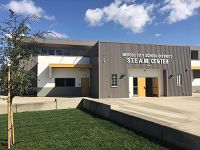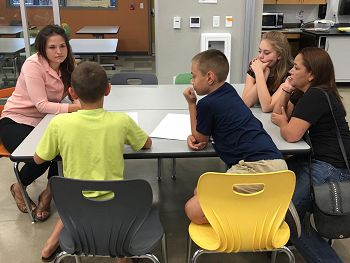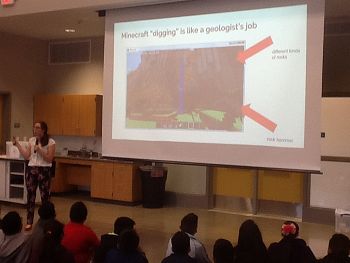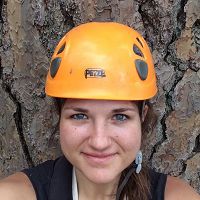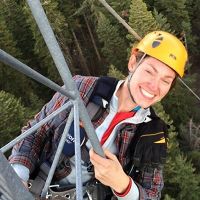Observatory scientists volunteer with students at new STEAM Center in Merced
Merced City School District opened a new STEAM Center earlier this year, a space for TK-8 students to experience 21st century, hands-on learning in science, technology, engineering, the arts, and mathematics (STEAM). Professionals working at University of California, Merced, have been volunteering at the STEAM Center to share their work and life stories, and to help students develop their own projects.
Kimber Moreland helps students brainstorm research questions and methods at Ask a Scientist or Engineer Night. Photo by Sara Sandrik (MCSD)
On October 18, graduate student and soil scientist Kimber Moreland attended Ask A Scientist or Engineer Night, when students have a chance to interact with professionals and develop their own science project. These elementary and middle school students will present their work at school science fairs later this school year, including at district- and county-wide showcases. Moreland described helping these young students as a new and rewarding experience for her. "I learned how to facilitate learning for this and not just give them my answer," she said. "I feel like it is meaningful work to be with kids who do not get to be around scientists."
UC Merced professor and SSCZO co-investigator Dr. Asmeret Asefaw Berhe similarly feels that it is important to be engaging with students. She gave a presentation to a group of nearly 100 sixth graders on September 27, talking about what it is like to be a scientist, what it means to be a professor, and soils and climate change. Berhe said, "I think every kid should have a chance to cultivate their creativity and imagine themselves in our careers, for them to know what it is like to lead a life dedicated to the endeavor of knowledge development and dissemination." She also wants students to walk away with greater understanding and appreciation of how the scientific process works. "...[S]ome segment of society is not aware of how we make scientific decisions and arrive at conclusions form our research. Hence, I strive to explain the scientific process, the value of education, and love of knowledge."
Michelle Gilmore tells students how part of the video game Minecraft is similar to some of the work geologists do. Photo by Adrienne Nau (MCSD)
Later in October, SSCZO Outreach Manager Michelle Gilmore discussed how she decided to pursue geology; the field, laboratory, and computer work involved in geologic research; the importance of geology in everyday life; and her hobbies. "I emphasized science and my passion for it, but I also wanted them to know that I am a person. I enjoy playing outside, family time, and silly pictures of cats probably as much as they do." Several students commented after her presentation that they didn't know there were scientists who spend time outdoors for work. "Most scientists aren't in lab coats all day," said Gilmore. "I hope that meeting scientists in different disciplines helps these children see the range of work we do, work they could do someday."
For these scientists, opening young students' eyes to different types of STEAM careers is only part of the motivation for volunteering at events like these. Shedding light on the diversity of the people in STEAM careers is also a major goal. Earth, space, and environmental science fields are noted for lacking diversity in workforce and college programs, by both gender and race and ethnicity. But even at younger ages, research shows that students' and parents' perceptions of science careers can reduce middle school girls' interest in science. Recent projects have shed light on barriers to career success for women and also worked to increase retention of underrepresented minorities in geoscience.
Moreland said that the volunteers at the Ask A Scientist or Engineer Night were "all women of varying ages and ethnicities." "I felt like my presence shows... younger people that there are people who look like them that do this, so maybe they can too."
Berhe emphasized, "[Girls] need to see that moms can be scientists and scientists can be moms."
Public misconceptions about science and scientists - who they are, what they do, and their motives and goals - has prompted popularity of a hashtag on social media: #actuallivingscientist. All three researchers agree that it is important for everyone to meet and get to know an actual living scientist, and that scientists need to reach out to the public and their local communities to make that happen.
STEAM professionals from UC Merced will continue visiting the STEAM Center. SSCZO Field Manager Erin Stacy will be presenting about her work in the spring semester, and Moreland and Gilmore also plan to continue volunteering.
Written by Michelle Gilmore
Kimber Moreland helps students brainstorm research questions and methods at Ask a Scientist or Engineer Night. Photo by Sara Sandrik (MCSD)
Michelle Gilmore tells students how part of the video game Minecraft is similar to some of the work geologists do. Photo by Adrienne Nau (MCSD)
News Category:
RESEARCH |
PEOPLE |
EDUCATION/OUTREACH
People Involved
CZO
-
Sierra, GRAD STUDENT
-
Sierra, INVESTIGATOR
-
Sierra, STAFF
-
Sierra, STAFF
Related News

New SSCZO comic artfully communicates research
19 Jul 2017 - Wonder what soils and sponges have in common? Or why some trees in the Sierra Nevada are dying while others are surviving? Find out in our new comic.
_200_200_80auto_s_c1.jpg)
High school research team visits SSCZO to study snowpack and tree canopy relationships
10 May 2016 - How do tree canopies affect winter wonderlands? Students from the Center for Advanced Research and Technology are finding out.
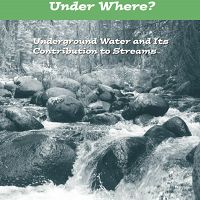
“Natural Inquirer” education journal features study by Southern Sierra researchers
01 Apr 2016 - A study by Southern Sierra Critical Zone Observatory researchers was featured in a recent issue of Natural Inquirer, a middle school...

TeenShale Network participants take to the stream
09 Nov 2016 - The 2016-2017 TeenShale cohort begins fifth year of water quality monitoring along Black Moshannon Creek, from Black Moshannon State Park to the...
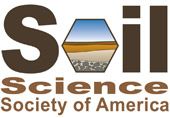
K-12 Soil Science Teacher Resources
24 Mar 2017 - The Soil Science Society of America (SSSA) is a professional scientific society, made up of soil scientists, educators, and consultants focused on...
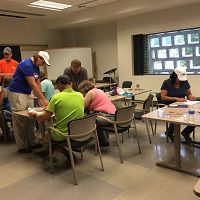
CZ Science in the Classroom
30 Nov 2016 - Members of the CZO National Office continue to hold workshops, presentions, posters and events in an effort to integrate CZ science at the K-12 and...

CZ themed issue of NAGT’s In the Trenches
31 Oct 2017 - This issue of In the Trenches explores the richly interdisciplinary concept of the Critical Zone (CZ).

Undergraduate course curriculum, “Introduction to Critical Zone Science,” available free online
01 Jan 2018 - A 15-week semester-long upper-level undergraduate course curriculum entitled “Introduction to Critical Zone Science” is now available free online.
Explore Further
